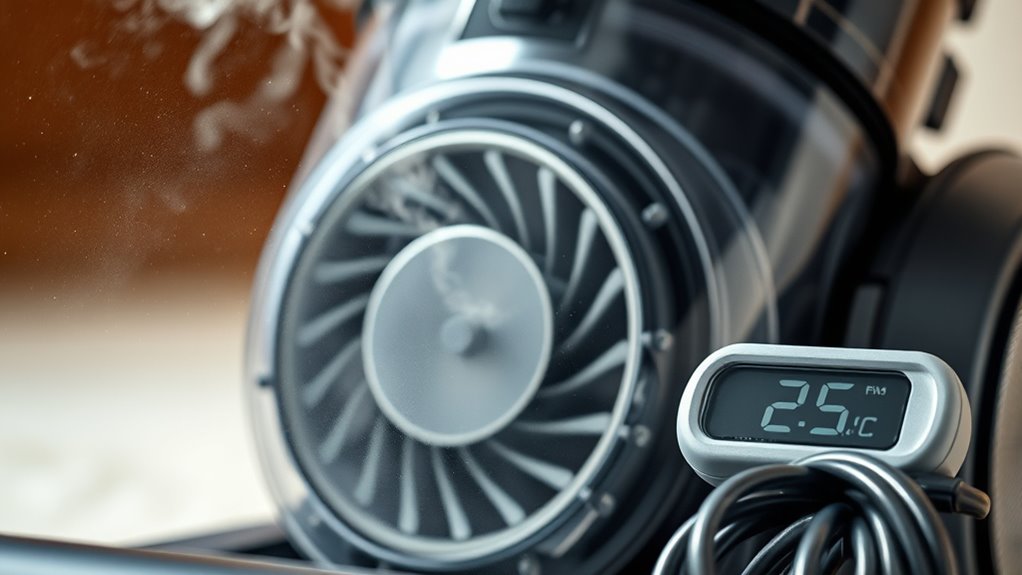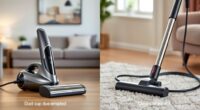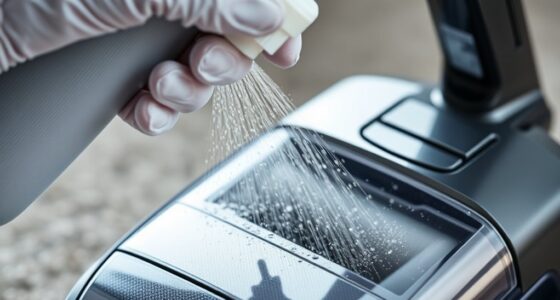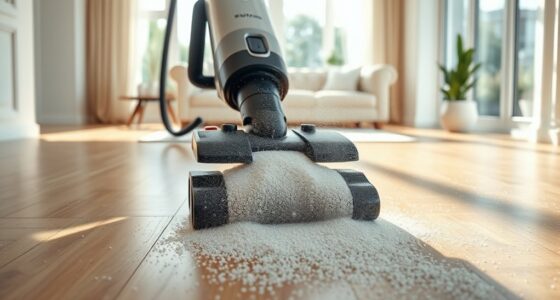Your vacuum might be overheating due to clogged filters, debris buildup, or extended use in MAX suction mode. These issues increase the motor’s workload and can lead to serious damage. Make sure you regularly check for blockages, clean the filters, and avoid using MAX mode for long periods. Empty the bag or canister when it’s mostly full to maintain airflow. Want to know more about keeping your vacuum running smoothly?
Key Takeaways
- Clogged filters and debris buildup restrict airflow, leading to increased motor strain and overheating.
- Extended use in MAX suction mode can overwork the motor, contributing to overheating issues.
- Regularly inspect hoses and brush rolls for blockages to ensure optimal airflow and prevent overheating.
- Maintain filters by cleaning or replacing them every 3-6 months to avoid airflow restrictions.
- Seek professional help if frequent overheating occurs, indicating potential underlying motor or electrical issues.
Common Causes of Vacuum Overheating

When you notice your vacuum overheating, it’s often due to a few common issues. Clogged filters can severely restrict airflow, forcing your motor to work harder and generate excess heat.
Overheating vacuums often result from clogged filters that restrict airflow and force the motor to work harder.
If you’ve been using your vacuum in MAX suction mode for an extended period, it increases the motor’s demands, contributing to overheating.
Debris accumulation in components like the filter and brush rolls further exacerbates heat buildup, straining the motor even more.
Operating on dense carpets or surfaces requires more energy, making it easier for the vacuum to overheat.
If there’s insufficient airflow caused by blockages, your vacuum may even trigger a thermal shutdown to protect the motor from damage.
Addressing these issues can help keep your vacuum running smoothly.
Symptoms of an Overheating Vacuum
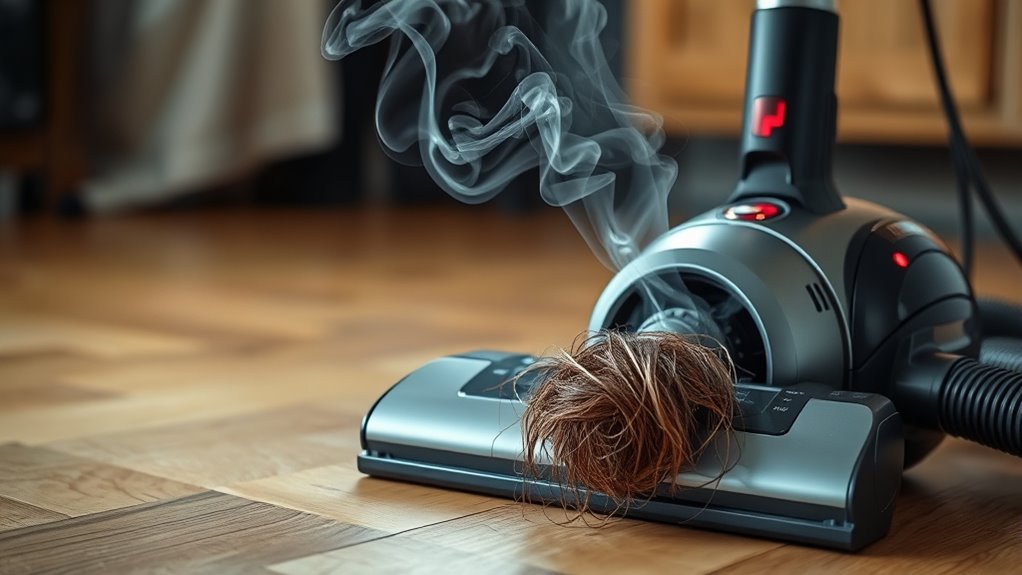
If your vacuum starts producing visible smoke or a burnt odor, it’s a clear sign that it’s overheating.
You might notice it shutting off after just a few minutes of use, indicating the thermal cut-out has kicked in to protect the motor.
Recognizing these symptoms early can help you avoid further damage and keep your vacuum running smoothly.
Visible Smoke or Burnt Odor
Visible smoke or a burnt odor from your vacuum is a clear sign that something’s gone wrong, often indicating an overheating motor.
If you experience this, it’s crucial to act quickly to prevent serious damage. Here are three common causes to bear in mind:
- Clogged Filters: Dirty filters restrict airflow, leading to overheating and reduced suction power.
- Obstructed Hoses: Any blockages in the hoses can create excessive strain on the motor, causing it to overheat.
- Worn-out Belts: Friction from damaged belts can generate heat, resulting in that burnt smell. Additionally, ensuring your vacuum has a high suction power can also help maintain optimal performance and prevent overheating.
Thermal Cut-Out Activation
Experiencing a thermal cut-out activation in your vacuum can be frustrating, as it means the motor has overheated and shut down to prevent damage.
Before this occurs, you might notice a significant reduction in suction power, indicating that something’s wrong. Often, the filter becomes clogged, contributing to the overheating issue.
Once activated, the thermal cut-out may leave your vacuum unusable for over six hours, which can be inconvenient. When you check the motor, it’ll likely feel excessively hot, confirming overheating.
If this happens frequently, it’s a sign of underlying problems, like blockages or worn components, that need immediate attention. Addressing these issues can help maintain peak vacuum performance and prevent further thermal cut-out activations.
How to Diagnose Overheating Issues
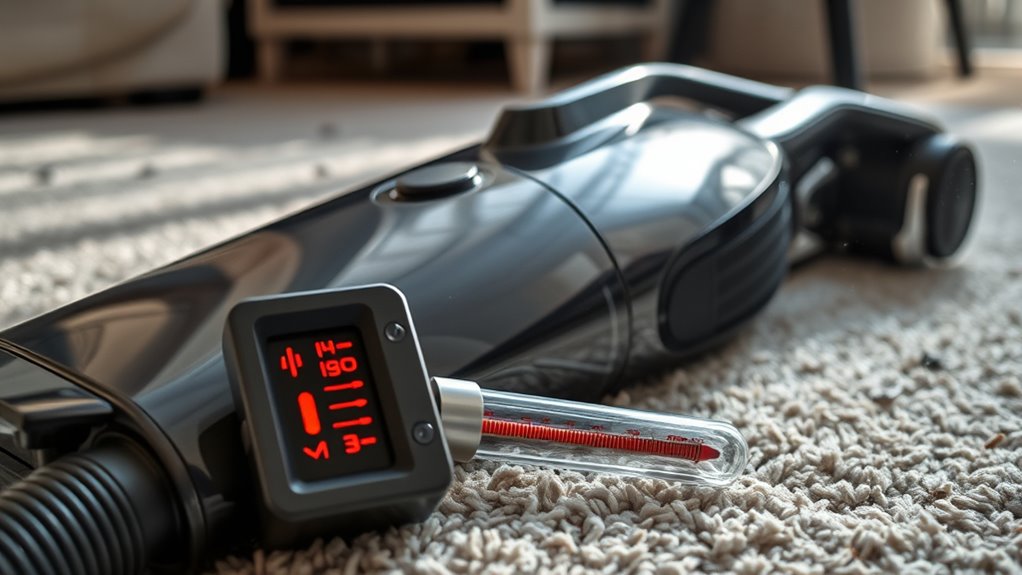
To diagnose overheating issues in your vacuum, start by checking for blockages that restrict airflow.
Next, inspect the motor components, paying close attention to the condition of the carbon brushes.
Finally, monitor the suction power to guarantee your vacuum is performing efficiently and not overheating.
Check for Blockages
When diagnosing overheating issues in your vacuum, checking for blockages is crucial, as even minor obstructions can lead to significant performance problems.
Here are some key areas to inspect:
- Hoses and Attachments: Look for any lodged debris that can reduce airflow, contributing to overheating.
- Brush Roll: Check for debris buildup that can hinder proper rotation and strain the motor, causing increased heat.
- Filters and Collection Container: Verify filters are clean and the vacuum bag or canister isn’t full, as these can restrict airflow and lead to overheating issues.
Regularly monitoring these areas will help maintain ideal performance and prevent overheating in your vacuum.
Inspect Motor Components
Inspecting motor components is essential for diagnosing overheating issues in your vacuum. Start by checking the condition of the carbon brushes; worn brushes can lead to poor motor performance and increased overheating.
Next, remove the motor cover to evaluate the commutator. Confirm it’s clean and free of debris, as any obstruction can impair functionality.
Don’t forget to inspect all filters, including HEPA and pre-filters, for clogs, since restricted airflow can cause the motor to overheat due to insufficient cooling. Make certain airflow paths, like hoses and air intake passages, are clear of obstructions.
Finally, monitor the motor temperature after a thermal shutdown to assess overheating severity, as consistently high temperatures may indicate the need for repair or replacement. Additionally, ensuring that you use a vacuum designed for high suction power may help prevent overheating by allowing efficient dirt removal and reducing strain on the motor.
Monitor Suction Power
Here are three steps to diagnose potential issues:
- Check for Suction: Place your palm over the tube attachment while the vacuum’s running. If there’s little to no suction, you may have clogs in the hose or filters.
- Inspect the Bag or Canister: Regularly check and clean the vacuum bag or canister. A full bag restricts airflow, forcing the motor to work harder and risking overheating.
- Observe During Use: Pay attention during prolonged use. If the vacuum shuts off or emits a burning smell, it’s likely overheating due to insufficient airflow or debris buildup. Additionally, consider the best HEPA filter vacuums to enhance filtration efficiency and reduce overheating risks.
Preventive Measures to Avoid Overheating
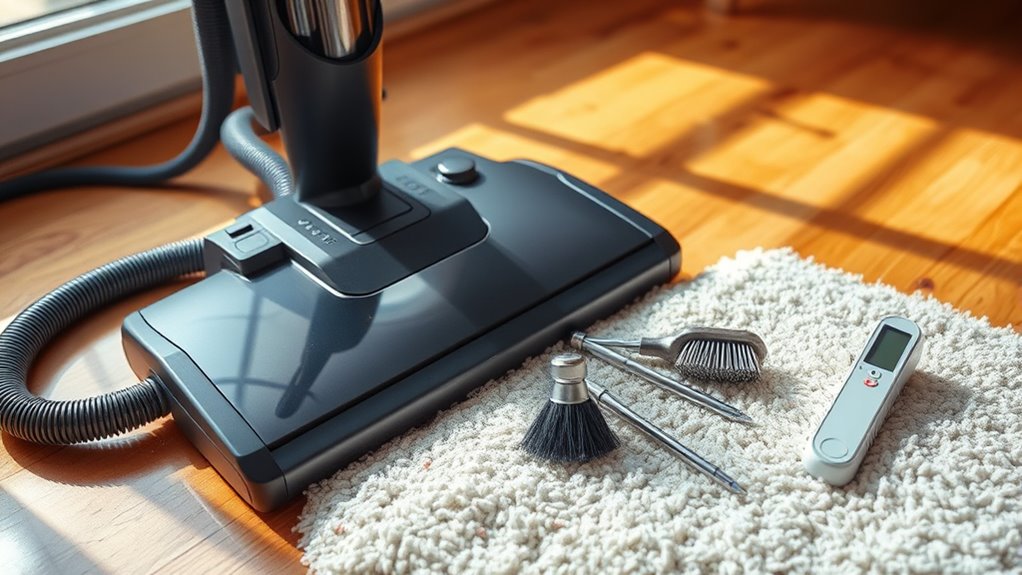
To keep your vacuum running smoothly and prevent overheating, regular maintenance is crucial.
Start by inspecting and cleaning the filters frequently, as clogged filters restrict airflow and can lead to motor overheating. Make certain to empty the vacuum bag or canister when it hits about 75% capacity to maintain peak airflow.
During your cleaning sessions, avoid using MAX suction mode for extended periods, as this puts extra strain on the motor. Additionally, conduct routine checks for blockages in hoses and brush rolls to guarantee unobstructed airflow.
Finally, schedule regular inspections of the vacuum’s components, like belts and carbon brushes, to catch potential issues before they cause overheating problems.
Steps for Maintaining Your Vacuum
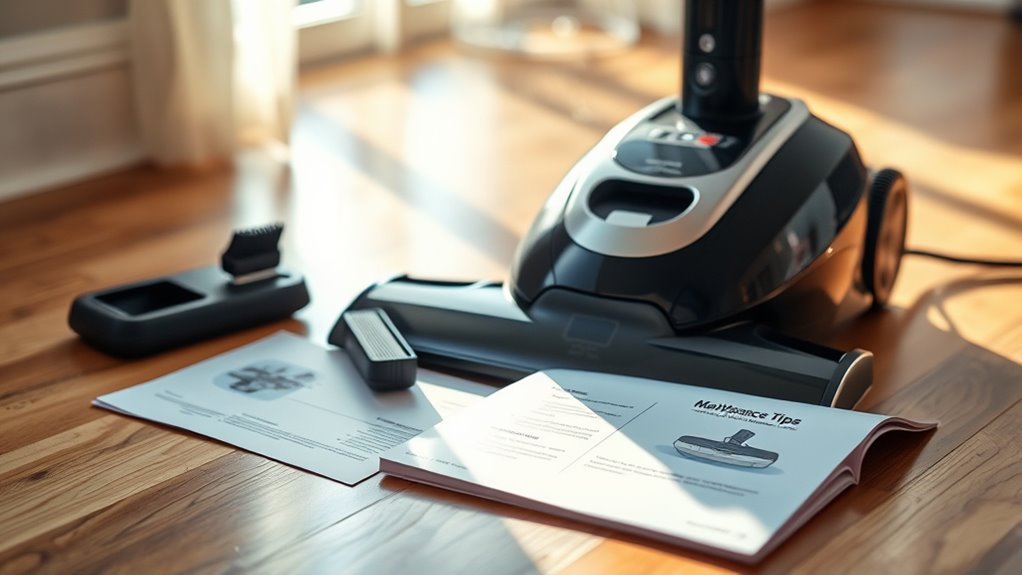
Maintaining your vacuum is essential for peak performance and longevity, especially since neglect can lead to overheating issues.
Follow these steps to keep your vacuum running smoothly:
- Inspect and clean the brush roll and hoses regularly to prevent blockages that can cause overheating.
- Replace or clean the filter bag or canister as recommended, ideally every 3-6 months, to guarantee proper airflow and reduce strain on the motor.
- Empty the vacuum bag or canister when it’s about 75% full to maintain suction efficiency and prevent clogged airflow.
Additionally, schedule routine maintenance checks every 6-12 months and avoid extended use in high-suction modes to give your vacuum the care it deserves. Regular cleaning can also enhance its performance on hardwood floors, ensuring effective dust removal.
Repairing an Overheating Vacuum
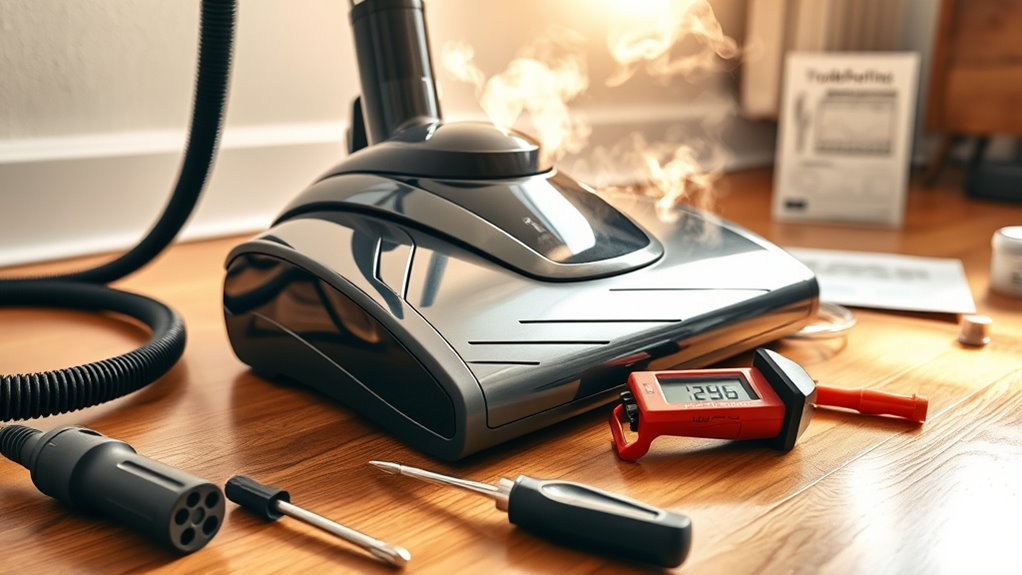
When your vacuum starts to overheat, it’s essential to act quickly to prevent further damage.
Begin by checking for blockages in the hose, brush roll, and air filter, as these can restrict airflow and cause the vacuum motor to overheat. Inspect the carbon brushes and commutator for wear; damaged components may create increased friction and heat.
If you find clogged or dirty filters, replace them according to the manufacturer’s recommendations to restore proper airflow.
Additionally, if the vacuum motor’s thermal overload switch frequently activates, it might indicate a need for a complete motor replacement.
Regular maintenance, like clearing debris from the brush roll and ensuring hoses are free of obstructions, can help prevent overheating and extend your vacuum’s lifespan.
Importance of Regular Filter Checks
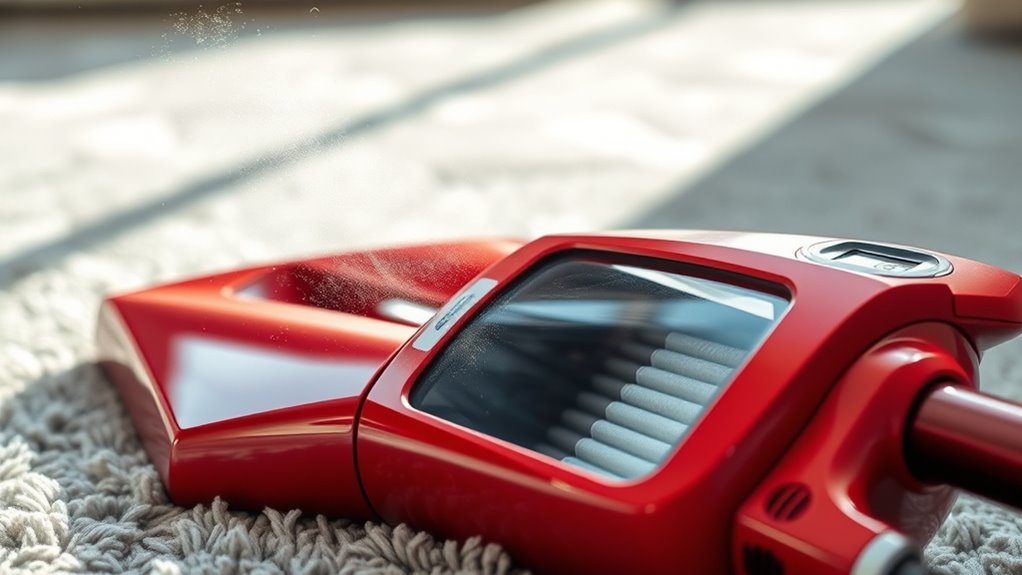
Regular filter checks are essential for keeping your vacuum running efficiently and preventing overheating. Neglecting filter maintenance can lead to clogged filters, which restrict airflow and force the motor to work harder. This increases the likelihood of overheating and potential shutdown.
To guarantee peak performance, follow these tips:
- Check Filters Regularly: Inspect filters at least once a month for dirt and debris.
- Clean or Replace as Needed: Clean reusable filters and replace disposable ones according to manufacturer guidelines.
- Monitor Suction Power: If you notice a decrease in suction, check the filters immediately.
When to Seek Professional Help
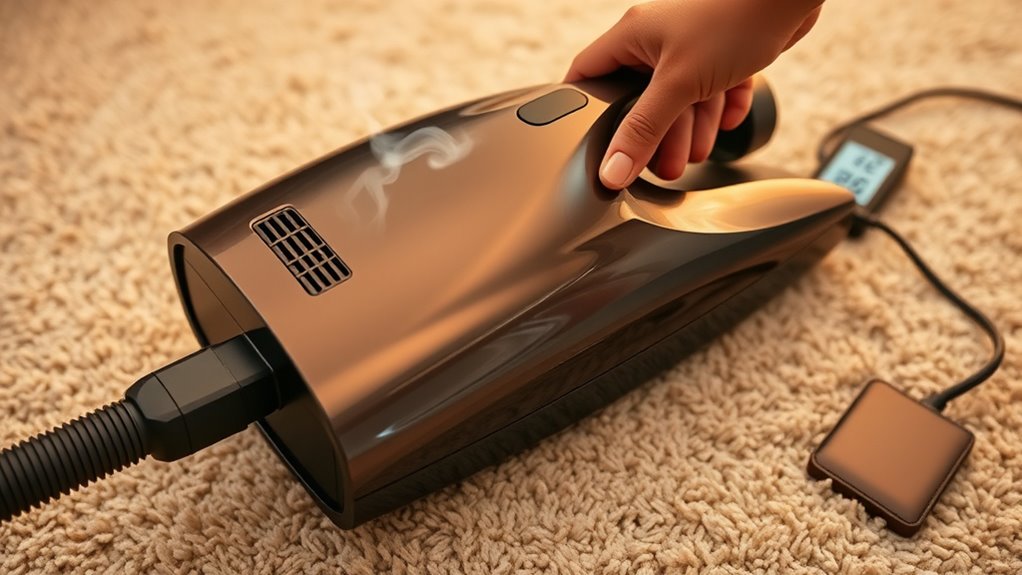
If your vacuum frequently overheats and shuts off, it’s time to contemplate seeking professional help. Ignoring persistent overheating can lead to serious mechanical issues that may worsen over time.
If you notice unusual noises or burning smells during operation, it’s essential to consult an expert to prevent potential motor damage. Additionally, if the thermal cut-out activates often, requiring long reset times, a professional can evaluate the motor and electrical components for underlying problems.
A significant drop in suction power, coupled with heating issues, indicates the need for expert intervention to address damaged carbon brushes or clogged motors.
If your vacuum shows signs of physical damage or wear, professional help guarantees safe and efficient operation.
Tips for Efficient Vacuum Usage
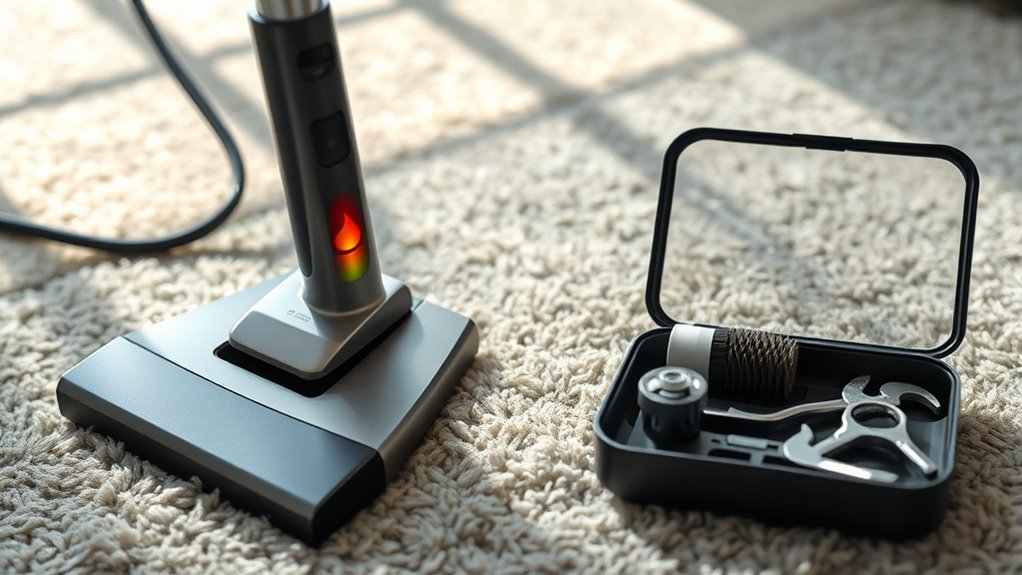
To keep your vacuum running efficiently, it’s essential to use it on the right setting for each surface type. This helps prevent unnecessary strain on the motor and reduces the risk of overheating.
Using the correct vacuum setting for each surface type prevents motor strain and reduces overheating risks.
Here are some tips for efficient vacuum usage:
- Adjust Settings: Use the appropriate setting for carpets, hard floors, or upholstery to enhance performance.
- Maintain Filters: Clean or replace filters regularly to guarantee ideal airflow and prevent overheating from clogged filters.
- Check Capacity: Empty the bag or canister when it’s about 75% full to maintain suction power and avoid overheating due to restricted airflow.
- Consider Smart Features: Utilizing smart features can optimize cleaning schedules and ensure your vacuum operates efficiently without overheating.
Frequently Asked Questions
What Would Cause a Vacuum to Overheat?
A vacuum can overheat for several reasons.
If you’ve got a clogged filter or brush roll, it’s restricting airflow, making the motor work harder.
Using MAX suction mode for too long also generates excess heat.
If you’re vacuuming dense carpets or using blocked hoses, the motor gets strained, leading to overheating.
Regularly check for debris and clean filters to keep your vacuum running efficiently and prevent overheating issues.
What Happens if a Vacuum Pump Overheats?
“When it rains, it pours.” If your vacuum pump overheats, it triggers a thermal cut-off, stopping the motor to prevent damage.
You’ll notice a drop in suction power, making your cleaning ineffective. Overheating wears out motor components like carbon brushes and bearings faster, leading to costly repairs.
Extended overheating can cause electrical failures, which may require professional help.
Regular maintenance is key to avoid these issues and keep your vacuum running smoothly.
Why Is My Shark Vacuum Overheating and Shutting Off?
If your Shark vacuum’s overheating and shutting off, it could be due to clogged filters or hoses that restrict airflow.
You might be using it on MAX suction mode for too long, generating excess heat.
Check for debris in the brush roll or air intake passages that could hinder performance.
Running it on thick carpets can also strain the motor.
Regular maintenance, like cleaning filters, can help keep your vacuum running smoothly.
Will a Vacuum Shut off if It Overheats?
Yes, your vacuum will shut off if it overheats.
Most vacuums have a safety feature that activates when the motor reaches a certain temperature, preventing damage. When this happens, you’ll need to let it cool down before using it again.
Keep an eye out for signs of overheating, like reduced suction power or excessive heat from the motor. Regularly checking for clogs and worn parts can help prevent these shutdowns.
Conclusion
So, before you plug in your vacuum again, take a moment to check for those signs of overheating. Ignoring the issue could lead to more than just a hot mess—it could mean costly repairs or even a new vacuum. By staying vigilant and following the preventive measures we discussed, you can keep your vacuum running smoothly. Don’t let overheating catch you off guard; your floors (and your wallet) will thank you!
